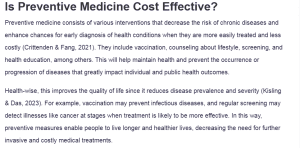Is Preventive Medicine Cost Effective?
Preventive medicine consists of various interventions that decrease the risk of chronic diseases and enhance chances for early diagnosis of health conditions when they are more easily treated and less costly (Crittenden & Fang, 2021). They include vaccination, counseling about lifestyle, screening, and health education, among others. This will help maintain health and prevent the occurrence or progression of diseases that greatly impact individual and public health outcomes.
Health-wise, this improves the quality of life since it reduces disease prevalence and severity (Kisling & Das, 2023). For example, vaccination may prevent infectious diseases, and regular screening may detect illnesses like cancer at stages when treatment is likely to be more effective. In this way, preventive measures enable people to live longer and healthier lives, decreasing the need for further invasive and costly medical treatments.
Notably, based on the economy of health, there has been much debate regarding the cost-effectiveness of preventive medicine. On one side, investing in prevention can bring about substantial long-term savings by reducing the burden on health care. Fewer people needing treatment for preventable chronic conditions, such as diabetes and cardiovascular diseases, can alleviate hospital overcrowding and reduce expenditures in health care. One study from the CDC has pointed out that preventive measures with high quality—tobacco cessation programs and early cancer screenings—because of the decrease in long-term health expenditures will bring positive cost-benefit ratios (CDC, 2024).
Nevertheless, this is controversial because not all preventive measures save costs. Some screenings or preventive programs involve high up-front fees; if a low-risk population is screened, it may not save the expenditure. Additionally, the effects of preventive practices on healthcare economics hinge on the population targeted, the frequency of interventions, and the long-term adherence of individuals to the recommendations for prevention. Despite these complexities, many experts note that preventive medicine, at large, promotes better population health and may offer economic benefits by shifting the focus from treatment to proactive management, provided it is well-targeted and prioritized for at-risk populations.
References
CDC. (2024, May 24). Health and economic benefits of tobacco use interventions. National Center for Chronic Disease Prevention and Health Promotion (NCCDPHP). https://www.cdc.gov/nccdphp/priorities/tobacco-use.html
Crittenden, F., & Fang, C. (2021). Focus: Preventive medicine. The Yale Journal of Biology and Medicine, 94(1), 1–3. https://www.ncbi.nlm.nih.gov/pmc/articles/PMC7995942/
Kisling, L., & Das, J. (2023, August 1). Prevention strategies. National Library of Medicine; StatPearls Publishing. https://www.ncbi.nlm.nih.gov/books/NBK537222/
ORDER A PLAGIARISM-FREE PAPER HERE
We’ll write everything from scratch
Question

Is Preventive Medicine Cost Effective?

